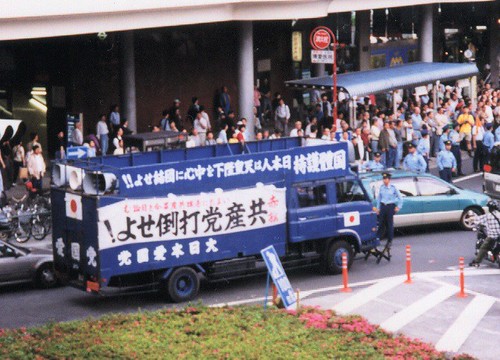I am currently reading Discrimination and Power (差別と権力), Akira Uozumi’s fascinating biography of Hiromu Nonaka, a former LDP heavyweight and cabinet minister known as a member of the burakumin, a minority outcast group who have suffered discrimination due to their historical role in feudal Japan as leather tanners and undertakers, vocations considered unclean. MFT readers will remember him as the man a New York Times article characterized as Japan’s version of Obama, as he too was a minority politician who rose to become a powerful politician.
I will post more on the book later, but for now I just want to share the following episode:
Just four months after Nonaka’s first successful bid* for the Diet’s lower house in 1983, the Kyoto Prefectural Police arrested the head of his koenkai (support association, kind of like a political action committee) for violating election laws. But Nonaka and associates were mostly able to beat the charges. Here is why:
You see, when Nonaka was first elected to the lower house he was already 57, a very late start for an LDP politician. But before that he had already made a very large name for himself in Kyoto prefectural politics as an anti-Communist conservative at a time when Kyoto had a Communist governor for more than two decades.
Part of the secret of Nonaka’s success was a questionable election tactic – when election season came around, construction executives friendly with Nonaka would mobilize housewives associations and other support groups to visit houses and run “get out the vote” campaigns in Nonaka’s home district of Sonobe and surrounding areas of Kyoto. Under Japanese election laws it was (and remains) illegal for politicians or their staff to visit people’s homes to ask for support, as it’s (correctly) assumed bribes will be forthcoming during such visits. However, Nonaka was able to get away with this for years as the construction executives ostensibly acted independently.
Eventually, police found evidence that during Nonaka’s first bid for the Diet, the voter mobilization efforts were in fact illegally run directly by the campaign. That’s when they moved to raid Nonaka’s offices, arrest the head of the koenkai, and question two leaders of the koenkai‘s youth bureau.
However, the charges never stuck due to a lack of evidence or confessions (subordinates were prosecuted for minor offenses but the investigation never spread) thanks to a flurry of expert moves by Nonaka’s people to undermine the investigation before, during, and after the fact. They included:
- Keep the top guy out of the loop. The ostensible head of the koenkai was in fact a figurehead who was never fully informed of the details.
- When all else fails, act like you’re too sick/crazy to answer questions. The two leaders of the koenkai‘s youth section (青年部) questioned on suspicion of deep involvement proved uncooperative in answering police questions. They would refuse to attend interrogation sessions by claiming to have diarrhea. If they did attend a session and the cops started to get the upper hand, they would go wild and start banging their heads against the wall to disrupt the proceedings.
- Destroy evidence. Koenkai membership lists and other relevant documents somehow got destroyed.
- Stay informed. Nonaka used his contacts inside the police force to get daily updates on the status of the investigation. A closely allied prefectural assemblyman actually stationed himself inside the office of the Kyoto police force’s second in command to hear reports from detectives. Uozumi’s source described the process as “just as if [the police] were teaching [Nonaka] how to respond as they investigated.”
- Keep them on their toes. At one point, Nonaka himself showed up at the Sonobe precinct and shouted at the lead investigator to release his koenkai youth section chief if he was not yet formally charged.
- Don’t forget to use some carrots along with your sticks. By keeping careful records of police administrators’ promotion status, Nonaka was able to bribe police bigwigs with cushy post-retirement positions at railroad companies and elsewhere (early in his career Nonaka worked for the national railway in Osaka). According to Uozumi, far from weakening Nonaka, the investigation ended up actually strengthening Nonaka’s political ties to the police.
From the beginning, the top brass in the police were hesitant to rock the boat since the politicians have a hand in deciding the police force’s budget. I can’t help but think they were a little prescient.
*from Kyoto’s 2nd district; he ran with (or more appropriately, against) Sadakazu Tanigaki and they each won a seat in the two-member district.



